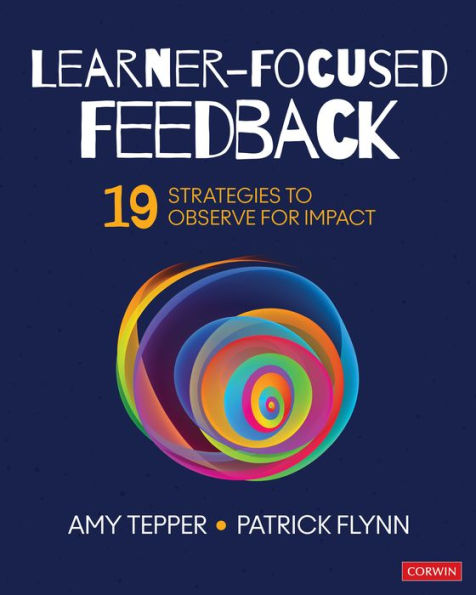
Learner-Focused Feedback: 19 Strategies to Observe for Impact
256
Learner-Focused Feedback: 19 Strategies to Observe for Impact
256eBookFirst Edition (First Edition)
Available on Compatible NOOK devices, the free NOOK App and in My Digital Library.
Related collections and offers
Overview
New strategies for feedback that supports a culture of learning
The skill set required for observing why students are learning and how teachers influence that is a difficult one to master—yet it’s essential when it comes to driving change and growth in your school. This companion to Feedback to Feed Forward provides a curated collection of strategies to improve your ability to identify desired outcomes, recognize learning in action, collect relevant and accurate evidence, and develop smart, supportive, and effective feedback about a teacher’s impact on learners.
And it’s not just leaders, coaches, and administrators who can use this highly accessible how-to. This time around, Tepper and Flynn also address the needs of teachers who double as observers, whether they’re mentoring new teachers, supporting each other or analyzing the effectiveness of their own teaching. No matter your role, you’ll benefit from their expert guidance, as well as:
· Authentic classroom examples
· Observer think-alouds
· Stories from the field with "Give-It-a-Try" tools and "Stop and Think" questions
· Follow-up steps specific to your role
When classroom observation and feedback are both learner-centered (focused on students) and learning-focused (focused on teachers as learners), they lead to a culture of learning throughout the school. Take this book as your guide, and explore just how effective your feedback can be.
View a full list of

Product Details
| ISBN-13: | 9781544368276 |
|---|---|
| Publisher: | SAGE Publications |
| Publication date: | 01/16/2020 |
| Sold by: | Barnes & Noble |
| Format: | eBook |
| Pages: | 256 |
| File size: | 6 MB |
About the Author
Patrick Flynn has worked as a teacher, teacher leader, curriculum director, and executive program director in K-12 settings in over eleven different states. As the Executive Director of High Schools for Edison Schools and the Chief Academic Officer for Great Schools Workshop in Sacramento, CA, Patrick worked with building and district administrations in nine states to implement systemic high school reform. He has provided professional learning in the areas of transformational leadership, performance management systems, standards-driven instruction, and data-driven decision-making. Patrick is Founder and Executive Director of ReVISION Learning Partnership, providing professional development and support to districts and educational organizations in CT, NY, NJ, and LA since 2010. He has led several school improvement initiatives in rural and urban settings and internationally in the United Arab Emirates with the Abu Dhabi Education Council. He has presented nationally and internationally, including as a keynote speaker at the Forum on Big Data at the Tianjin University of Technology, in Tianjin, China. ReVISION Learning is highly sought after for its leadership in providing the highest quality professional learning opportunities for teacher, administrators, and district personnel.
Table of Contents
List of Online ResourcesFeedback to Feed Forward Strategies
Preface
Acknowledgments
About the Authors
Chapter 1: Why Observe for Impact?
Building a Culture of Learning
Building a Culture of Observation and Feedback
The Skills of Observation
Teachers as Learners
Leaders Leading Learning
What’s Ahead
Chapter 2: What Do You Need to Understand About Learning?
Understanding the Concept of Learning
Overarching Goals for All Learners
Our Three Goals
Cautions for Observers
How the Brain Works
Identifying Learning in Action
Recognizing Impact on Learning
Determining Causal Attribution
Give It a Try
What’s Ahead
Chapter 3: How Can You Prepare for Evidence Collection?
Preobservation Planning
Planning Your Tools
Planning by Using Expectations
Planning to Interact With Learners
Planning Using Learning Goals
Planning Based on Disciplines
Planning Based on Standards
Give It a Try
What’s Ahead
Chapter 4: How Can You Adapt Evidence Collection Upon Arrival?
Your Goals as an Observer
Adapting 101: The Basics
Metacognition in Motion
Making It Count
Timing Is Everything
Using the Learning Goals
Foundational Understandings
Student Ability to Meet Expectations
Give It a Try
What’s Ahead
Chapter 5: How Can You Adapt Evidence Collection as a Lesson Unfolds?
Observing for Learning
Observing for Causal Attribution and Impact
Observing for Good Struggle
Adapting During an Observation
Adapting Based on Active Engagement
Student Notes
Mid-Lesson or End-of-Task/End-of-Lesson Reflections
Adapting Based on Tools and Resources
Adapting Based on Discourse
Give It a Try
What’s Ahead
Chapter 6: How Do You Cultivate a Culture of Learning?
Building a Culture of Learning
Developing Feedback About Impact
Building Trust
Making a Culture Shift
The Six Steps
Final Thoughts
Strategies List
List of Figures
References
Index
